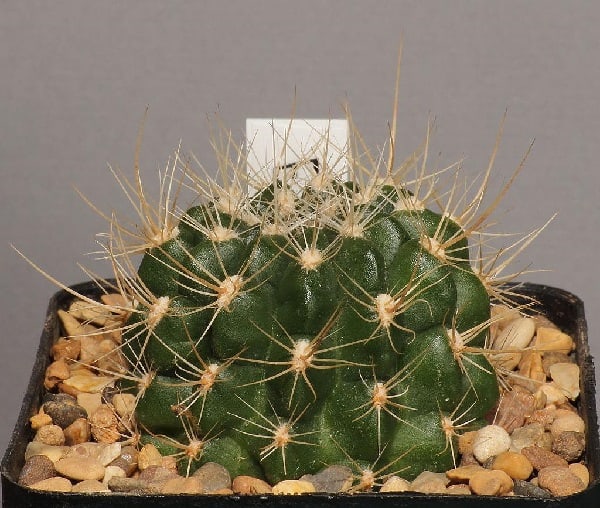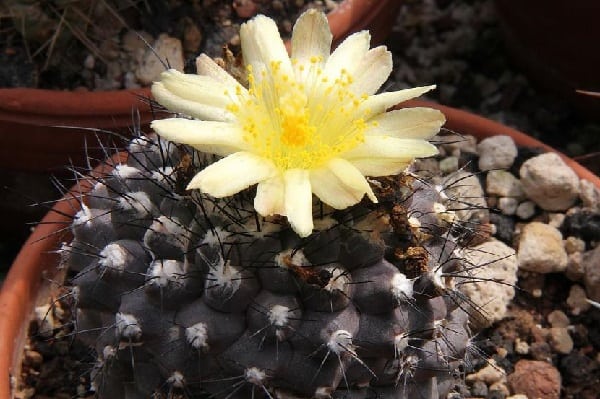Is Your Cactus in Peril? Watch Out for These Indicators
We really like cacti, but boy, dealing with watering can be tough! It’s a challenge to get it just right, even if you’ve been taking care of these plants for a while. Sometimes we water too little, and other times we water too much. Unfortunately, this can prevent our lovely prickly plants from growing properly.
So, here’s a question we often ask ourselves, especially when we’re new to cactus care: How can we tell if our cactus is dying? If it is, we might think it’s a lost cause. Or maybe there’s still a chance to save it?

Contents
How to Tell if Your Cactus is Dying
- Spots (yellow, brown, or black) appearing on the cactus
- The cactus collapses or appears weak and unable to support itself
- Wrinkling of the cactus, indicating a loss of firmness
- Mushy texture or development of a brownish color
When it comes to determining whether your cactus is dying, it’s important to observe any changes in its appearance. A healthy cactus typically remains the same visually, showing no signs of distress.
However, things start to get concerning when you notice certain alterations in its appearance. Keep an eye out for spots appearing on your cactus. These spots can present themselves as patches of yellow, brown, or black. Additionally, a dying cactus might exhibit signs of collapse, appearing weak and unable to support itself properly. It could also become wrinkled as if it’s losing its firmness. Another indicator of trouble is when the cactus becomes mushy or develops a brownish color, which may suggest that it’s deteriorating.
Remember, these changes in appearance are not a good sign and can indicate that your cactus is struggling to survive. If you notice any of these signs, it’s essential to take immediate action and provide the necessary care to help revive your struggling plant.
How to Tell if a Cactus is Dead
It can be disheartening to see a cactus in a sorry state, but how can you know if it’s truly beyond saving? Here’s how to determine if a cactus is dead:
- Check the Appearance: Look closely at the cactus and observe its overall appearance. If the cactus looks shriveled, brown, and dry, it may be a sign that it has dried out completely and is no longer alive. Also, if there are any visible signs of decay, such as soft and mushy spots or dark, blackened areas, it could indicate that the cactus has succumbed to rot.
- Conduct the Squeeze Test: Gently squeeze the cactus with your gloved hand. A healthy cactus should be firm to the touch. If it feels soft and squishy, it’s likely an indicator of internal damage or decay.
- Check for Growth: Examine the top portion of the cactus. If there is no new growth or any signs of new buds or spines, this could be a sign that the cactus is no longer alive. Healthy cacti usually exhibit signs of growth and new development.
- Perform the Scratch Test: Using a small stick or your gloved hand, scratch the outer layer of the cactus. If you notice a greenish hue underneath the surface, it indicates that the cactus is still alive. However, if the scratched area appears brown or dry, it’s likely a sign of a dead cactus.
Remember, even if a cactus appears dead, it’s possible to revive it if you catch it early enough. However, if you have tried all the necessary reviving techniques and the cactus does not respond, it might be time to consider it as deceased.
How to Tell if a Cactus is Healthy
Determining the health of your cactus is essential to ensure it thrives and continues to bring joy to your space. Here are some signs to help you assess if your cactus is healthy:
- Check the Color: A healthy cactus typically has vibrant and consistent coloration throughout its body. Bright and green hues are signs of a well-nourished cactus. However, keep in mind that some cacti naturally have variations in color, so it’s crucial to familiarize yourself with the typical appearance of your specific cactus species.
- Examine the Spines: Inspect the spines of the cactus. They should be evenly distributed and firmly attached to the body. If you notice any signs of discoloration, wilting, or falling spines, it might be an indication of a health issue. Additionally, be cautious when handling cacti with sharp spines to prevent injuries.
- Assess the Stem: The stem of a healthy cactus should be firm and upright, demonstrating its ability to support the plant’s weight. Be on the lookout for any signs of shriveling, puckering, or softness, as these can be indications of dehydration or pests affecting the plant.
- Growth and Development: Healthy cacti exhibit signs of growth. Look for new shoots, buds, or spines sprouting from the body of the cactus. These are positive indicators that your cactus is actively growing and thriving. It’s also important to note that cacti grow slowly, so be patient when assessing growth.
- Water Storage: Cacti are renowned for their ability to store water, which helps them survive in arid environments. A healthy cactus should appear plump and taut. If the cactus appears excessively shriveled or wrinkled, it may require watering.
Remember that different cactus species have unique characteristics and growth patterns, so it’s helpful to research and understand the specific needs of your cactus variety. Regular observation and proper care are key to maintaining a healthy cactus that can thrive for years to come.
Why is My Cactus Dying?
Well, just like everything in life, there are a few reasons why a cactus might die. It depends on a few things like the cactus itself, the time of year, how much, and how often we water it. When a healthy cactus is touched, it feels firm, except when we press it a little and its fleshy body gives way slightly.
But what if you’re not giving your cactus enough light or you’re not watering it properly? In these cases, the cactus becomes soft. If it doesn’t receive enough light, it will stretch towards any light source it can find. This is called etiolation and the new stems that grow will be weak, often unable to support themselves, and will fall.
On the other hand, if you’re not watering your cactus as often as you should, it can get sick. Here are the symptoms:
- Overwatering: When the roots suffocate and the fleshy body rots quickly.
- Underwatering: If a cactus doesn’t receive water for a long time, it will use up the stored water in its body to survive. As a result, the plant starts to “wrinkle” as it runs out of precious liquid.
How to Prevent a Cactus from Dying
To keep your cactus healthy, here are three things you can do:
- Use a substrate that has good drainage, like pumice or a mix of black peat and perlite in equal parts.
- Before watering, check the soil’s humidity by inserting a thin wooden stick. If it comes out mostly clean, the soil is dry and needs watering. Alternatively, you can lift the pot and compare its weight before and after watering to determine when it needs water.
- Place your cactus in an area with plenty of sunlight. Avoid semi-shaded or shaded spots as cacti thrive in direct sunlight. However, make sure to introduce your cactus gradually to avoid shock.

How to Revive a Dying Cactus
If your cactus is rotting but hasn’t deteriorated too much, there’s still hope to save it. Make sure the upper part of the cactus is healthy and not wrinkled or mushy.
Here’s what you should do:
- Wear thick gloves or use a piece of paper to protect your hands from the cactus spines. Carefully cut off the healthy part using a sharp and clean knife. Ensure there are no signs of decay. To prevent infection, apply cinnamon to the wound.
- For Euphorbias, run warm water over the cut part for a few minutes to stop sap from oozing.
How to bring a cactus back to life:
- Allow the cut wound to dry completely before planting. In some cases, it’s possible to plant freshly cut cacti, but this presents a risk of rotting. Wait at least 24 hours before placing the cactus in the substrate. Cacti have water reservoirs in their tissue, allowing them to go without water for quite some time. Don’t worry if a hardened layer forms on the wound; it acts as a protective barrier against mold and pathogens, ensuring a healthy root formation.
- Select a mineral-rich substrate designed for cacti to encourage rooting. Avoid humus-rich soil typically used for other plants. When purchasing cactus soil, check its composition.
- Fill a planter with the substrate, slightly moisten it, and carefully press the cactus into the soil.
- After planting, take care not to water the cactus for at least a week. Different cacti take varying amounts of time to root. Some may show new roots within days, while others may take up to three months. In some cases, the lower part of the cactus may regenerate with more light. Over time, the wound will become tough, and new growth will appear at the edges.
Pro Tip:
Maintaining a balanced relationship between light and water is crucial. Signs of a dying cactus often indicate an imbalance.
Offshoot
Many cacti produce offshoots, which are recognizable by the constrictions along the main stem. If your cactus develops such offshoots, you can simply cut them off at the constriction and plant them in a substrate low in nutrients but high in minerals. This not only saves the rotting cactus but also enables rejuvenation and multiplication.
